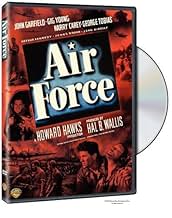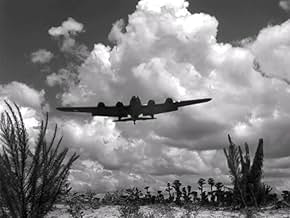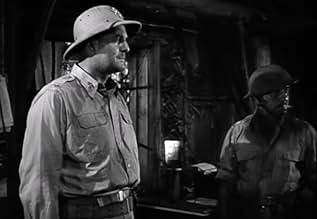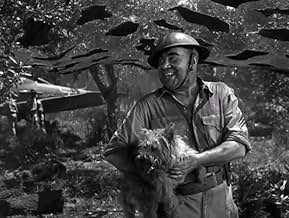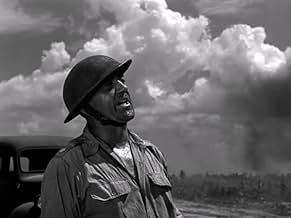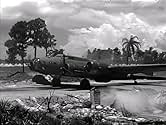Air Force
- 1943
- Tous publics
- 2h 4min
L'équipage d'un bombardier de l'Air Force arrive à Pearl Harbor au lendemain de l'attaque japonaise et est envoyé à Manille pour aider à la défense des Philippines.L'équipage d'un bombardier de l'Air Force arrive à Pearl Harbor au lendemain de l'attaque japonaise et est envoyé à Manille pour aider à la défense des Philippines.L'équipage d'un bombardier de l'Air Force arrive à Pearl Harbor au lendemain de l'attaque japonaise et est envoyé à Manille pour aider à la défense des Philippines.
- Réalisation
- Scénario
- Casting principal
- Récompensé par 1 Oscar
- 3 victoires et 3 nominations au total
- Marine Sgt. J.J. Callahan
- (as Edward S. Brophy)
Avis à la une
The plane leaves 12/6/41 for Hickam Field in Hawaii and we know what happened the next day. The Mary Ann lands and takes off and makes a bunch of stops where the Japanese are attacking. In the end they are part of a nasty battle.
Warner Brothers special effects was at the top of its game. The cast is perfectly suited for their roles right down to a dog that gets hostile at the name Moto. Captain John Ridgely's death scene is the dramatic highlight of the film.
Air Force got an Oscar for film editing. It's a wartime flag waver to be sure but it still holds up well today.
Don't kid yourself that Hollywood no longer makes "propaganda" films. They are making them now more than ever. The films are just a different type of "propaganda".
Le saviez-vous
- AnecdotesBecause of the constant noise in the planes, air crews wore "throat mics." These had two pickups that sat against the larynx (vocal cords) and picked the sound up directly from them. You will notice that whenever a crew member speaks he puts his hand up against the mic and presses it against his throat. This helped ensure good sound pickup.
- GaffesUnseen "snipers" attack the "Mary Ann" while at Maui. No Japanese "snipers" landed anywhere in the Hawaiian Islands during the attack.
- Citations
Radio Operator Peterson: [looking down] That's an awful big town, San Francisco.
Assistant Crew Chief Weinberg: Strictly a one whistle stop. There's only one city in the U.S.A. and that's New York.
Sgt. Robbie White: Oh, you're just a hometown hick, Weinberg. What's wrong with California?
Assistant Crew Chief Weinberg: California? The sun shines and nuthin' ever happens. Before you know it, you're 60 years old.
Sgt. Robbie White: It's no different from New York. My sister's been tryin' to get out of Brooklyn for the last 40 years.
Assistant Crew Chief Weinberg: Brooklyn? That ain't New York, chief. Once you cross that Brooklyn Bridge, you're outta this woild. The only noise you hear is the hardening of your arteries. You know when I used to drive a hack, I had a pal who crossed that bridge in 1929. Ain't ever heard from him since.
Radio Operator Peterson: Me, I'll take Minneapolis.
Assistant Crew Chief Weinberg: Minneapolis? Why, the grass still grows in the streets. Besides, that ain't your hometown, Peterson. The hayseed's still stickin' outta your hair.
Radio Operator Peterson: Yeah, but I can still milk a cow. I bet you can't.
Assistant Crew Chief Weinberg: I'll get mine outta a bottle. That's the closest I ever wanna be to a cow.
Sgt. Robbie White: You are handy with the old bull.
Assistant Crew Chief Weinberg: [laughs]
- Crédits fousOpening credits prologue: FOREWORD "It is for us the living .... to be dedicated here to the unfinished work which they who fought here have thus far so nobly advanced ..... It is ......for us to be here dedicated to the great task remaining before us ..... that this nation, under God, shall have a new birth of freedom and that government of the people, by the people, for the people, shall not perish from the earth." Abraham Lincoln
- ConnexionsEdited into Les orages de la guerre: Part IV (1988)
- Bandes originalesThe Army Air Corps Song
(1939) (uncredited)
("Off We Go Into the Wild Blue Yonder")
Written by Robert Crawford
Played during the opening credits and often throughout the film
Meilleurs choix
- How long is Air Force?Alimenté par Alexa
Détails
Box-office
- Budget
- 2 646 000 $US (estimé)
- Durée2 heures 4 minutes
- Couleur
- Rapport de forme
- 1.37 : 1
Contribuer à cette page



